Abstract
1. Human muscle endurance is apparently enhanced during maximal voluntary contractions at short muscle lengths (McKenzie & Gandevia, 1987) but the ability of subjects to activate muscles fully at short lengths has not been established. Therefore this study examined the voluntary capacity to activate muscles fully at control (near resting) lengths and at decreased muscle lengths. Changes in mechanical properties of twitch responses to electrical stimulation of relaxed muscles at short muscle lengths were also documented. The abductor digiti minimi, elbow flexors and tibialis anterior were studied in five subjects. 2. For the three muscle groups, the mean reduction in twitch force between the control and short muscle lengths ranged from 46-51%. AT the short length there was a 9-13% reduction in the contraction time and a 21-27% reduction in the half-relaxation time. Maximal voluntary force declined by 21-49% at the short muscle length. A reduction in muscle length produced a shift to the right of the force-frequency curve as determined by brief trains of electrical stimuli. 3. During maximal efforts single or brief trains of two to four supramaximal stimuli, delivered to the parent nerve or motor point, failed to increase the force at a latency appropriate for onset of a muscle twitch in some but not all attempts. Each subject achieved 'maximal activation' of the muscle in a similar proportion of attempts at the control and short muscle lengths. 4. These results suggest that maximal voluntary activation of motoneurone pools is possible at short muscle lengths and that the central nervous system is able to maintain the discharge of motoneurones close to 'fusion' frequency despite a decrease in the temporal characteristics of the isometric twitch.
Full text
PDF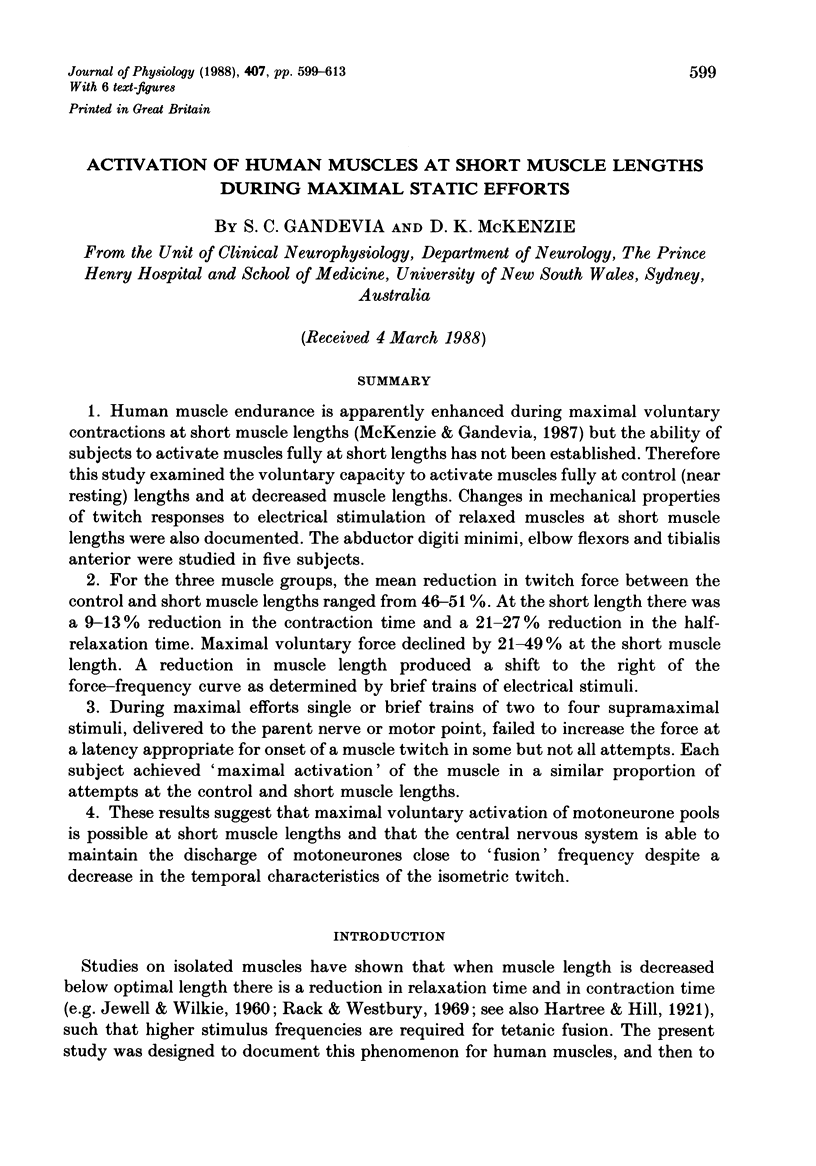
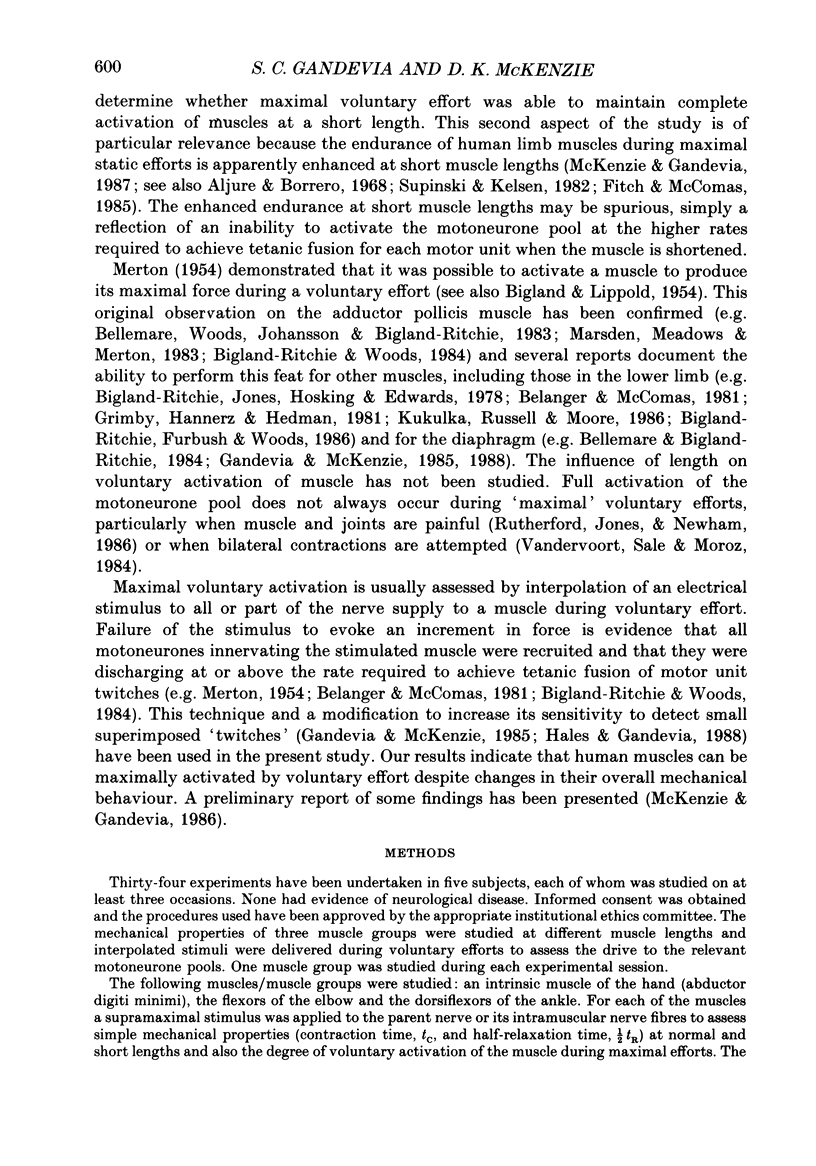
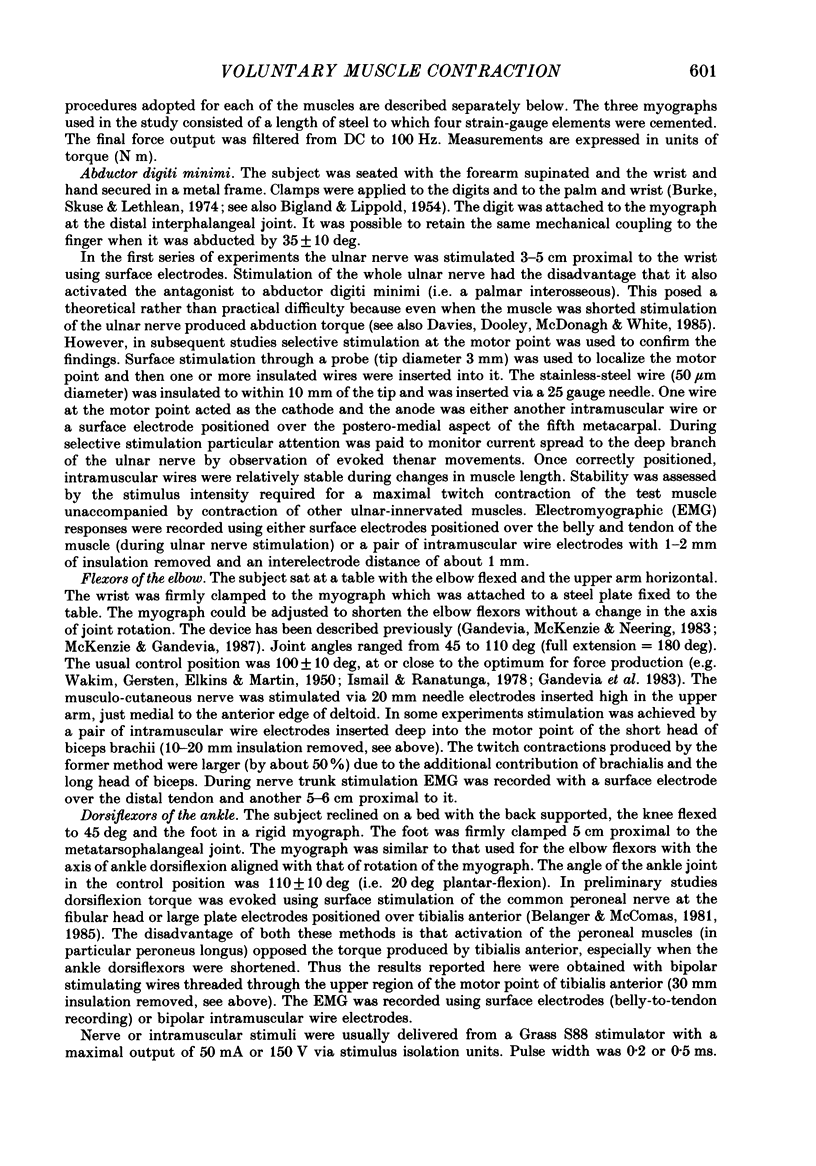

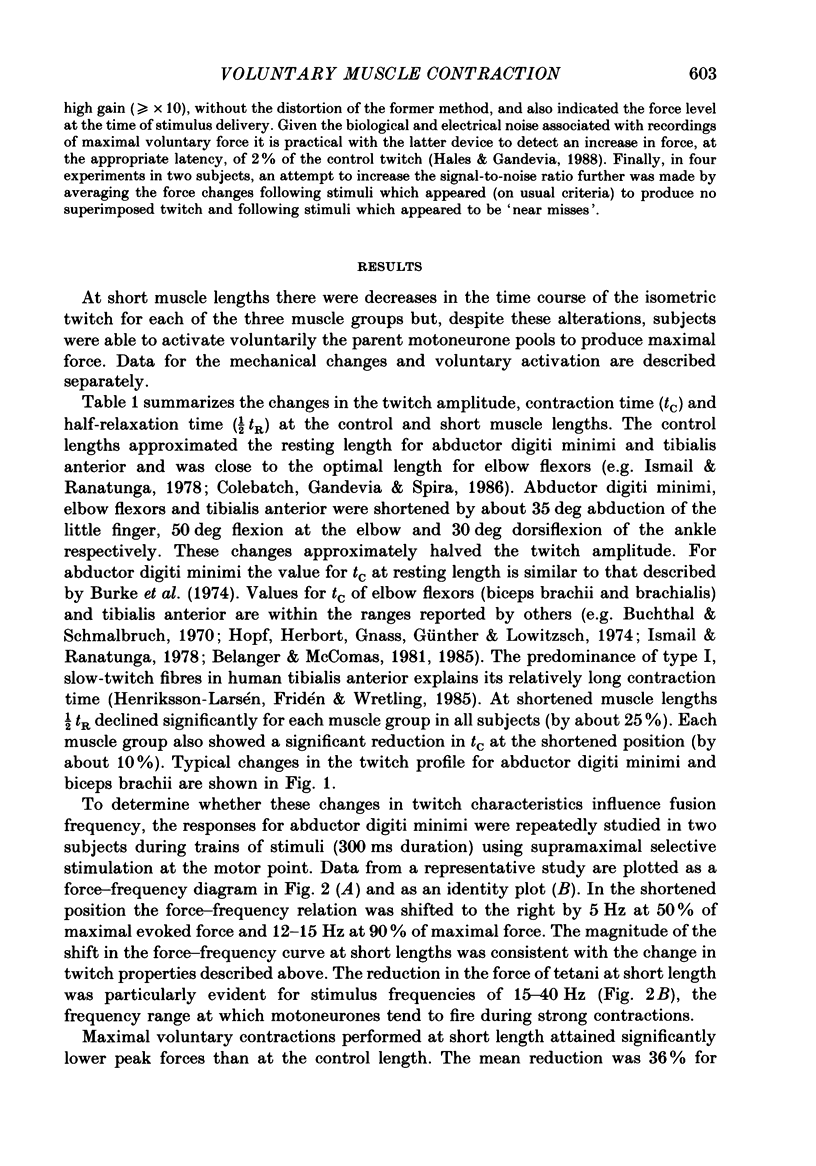






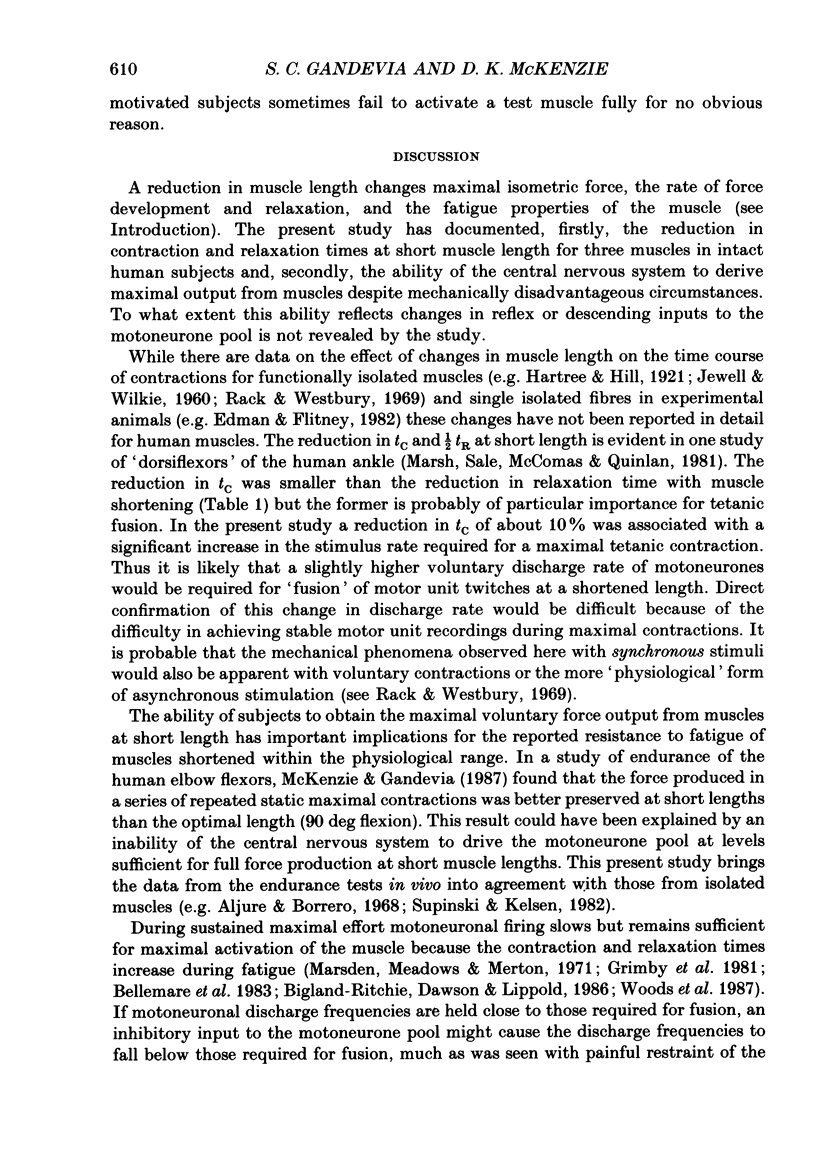



Selected References
These references are in PubMed. This may not be the complete list of references from this article.
- Aljure E. F., Borrero L. M. The influence of muscle length on the development of fatigue in toad sartorus. J Physiol. 1968 Dec;199(2):241–252. doi: 10.1113/jphysiol.1968.sp008651. [DOI] [PMC free article] [PubMed] [Google Scholar]
- Aniss A. M., Gandevia S. C., Milne R. J. Changes in perceived heaviness and motor commands produced by cutaneous reflexes in man. J Physiol. 1988 Mar;397:113–126. doi: 10.1113/jphysiol.1988.sp016991. [DOI] [PMC free article] [PubMed] [Google Scholar]
- BIGLAND B., LIPPOLD O. C. Motor unit activity in the voluntary contraction of human muscle. J Physiol. 1954 Aug 27;125(2):322–335. doi: 10.1113/jphysiol.1954.sp005161. [DOI] [PMC free article] [PubMed] [Google Scholar]
- Belanger A. Y., McComas A. J. Extent of motor unit activation during effort. J Appl Physiol Respir Environ Exerc Physiol. 1981 Nov;51(5):1131–1135. doi: 10.1152/jappl.1981.51.5.1131. [DOI] [PubMed] [Google Scholar]
- Bellemare F., Bigland-Ritchie B. Assessment of human diaphragm strength and activation using phrenic nerve stimulation. Respir Physiol. 1984 Dec;58(3):263–277. doi: 10.1016/0034-5687(84)90003-3. [DOI] [PubMed] [Google Scholar]
- Bellemare F., Woods J. J., Johansson R., Bigland-Ritchie B. Motor-unit discharge rates in maximal voluntary contractions of three human muscles. J Neurophysiol. 1983 Dec;50(6):1380–1392. doi: 10.1152/jn.1983.50.6.1380. [DOI] [PubMed] [Google Scholar]
- Bigland-Ritchie B. R., Dawson N. J., Johansson R. S., Lippold O. C. Reflex origin for the slowing of motoneurone firing rates in fatigue of human voluntary contractions. J Physiol. 1986 Oct;379:451–459. doi: 10.1113/jphysiol.1986.sp016263. [DOI] [PMC free article] [PubMed] [Google Scholar]
- Bigland-Ritchie B., Furbush F., Woods J. J. Fatigue of intermittent submaximal voluntary contractions: central and peripheral factors. J Appl Physiol (1985) 1986 Aug;61(2):421–429. doi: 10.1152/jappl.1986.61.2.421. [DOI] [PubMed] [Google Scholar]
- Bigland-Ritchie B., Jones D. A., Hosking G. P., Edwards R. H. Central and peripheral fatigue in sustained maximum voluntary contractions of human quadriceps muscle. Clin Sci Mol Med. 1978 Jun;54(6):609–614. doi: 10.1042/cs0540609. [DOI] [PubMed] [Google Scholar]
- Bigland-Ritchie B., Woods J. J. Changes in muscle contractile properties and neural control during human muscular fatigue. Muscle Nerve. 1984 Nov-Dec;7(9):691–699. doi: 10.1002/mus.880070902. [DOI] [PubMed] [Google Scholar]
- Buchthal F., Schmalbruch H. Contraction times and fibre types in intact human muscle. Acta Physiol Scand. 1970 Aug;79(4):435–452. doi: 10.1111/j.1748-1716.1970.tb04744.x. [DOI] [PubMed] [Google Scholar]
- Burke D., Skuse N. F., Lethlean A. K. Isometric contraction of the abductor digiti minimi muscle in man. J Neurol Neurosurg Psychiatry. 1974 Jul;37(7):825–834. doi: 10.1136/jnnp.37.7.825. [DOI] [PMC free article] [PubMed] [Google Scholar]
- Bélanger A. Y., McComas A. J. A comparison of contractile properties in human arm and leg muscles. Eur J Appl Physiol Occup Physiol. 1985;54(3):326–330. doi: 10.1007/BF00426154. [DOI] [PubMed] [Google Scholar]
- Colebatch J. G., Gandevia S. C., Spira P. J. Voluntary muscle strength in hemiparesis: distribution of weakness at the elbow. J Neurol Neurosurg Psychiatry. 1986 Sep;49(9):1019–1024. doi: 10.1136/jnnp.49.9.1019. [DOI] [PMC free article] [PubMed] [Google Scholar]
- Davies C. T., Dooley P., McDonagh M. J., White M. J. Adaptation of mechanical properties of muscle to high force training in man. J Physiol. 1985 Aug;365:277–284. doi: 10.1113/jphysiol.1985.sp015771. [DOI] [PMC free article] [PubMed] [Google Scholar]
- Edman K. A., Flitney F. W. Laser diffraction studies of sarcomere dynamics during 'isometric' relaxation in isolated muscle fibres of the frog. J Physiol. 1982 Aug;329:1–20. doi: 10.1113/jphysiol.1982.sp014287. [DOI] [PMC free article] [PubMed] [Google Scholar]
- Fitch S., McComas A. Influence of human muscle length on fatigue. J Physiol. 1985 May;362:205–213. doi: 10.1113/jphysiol.1985.sp015671. [DOI] [PMC free article] [PubMed] [Google Scholar]
- Gandevia S. C., McKenzie D. K. Activation of the human diaphragm during maximal static efforts. J Physiol. 1985 Oct;367:45–56. doi: 10.1113/jphysiol.1985.sp015813. [DOI] [PMC free article] [PubMed] [Google Scholar]
- Gandevia S. C., McKenzie D. K. Human diaphragmatic endurance during different maximal respiratory efforts. J Physiol. 1988 Jan;395:625–638. doi: 10.1113/jphysiol.1988.sp016938. [DOI] [PMC free article] [PubMed] [Google Scholar]
- Gandevia S. C., McKenzie D. K., Neering I. R. Endurance properties of respiratory and limb muscles. Respir Physiol. 1983 Jul;53(1):47–61. doi: 10.1016/0034-5687(83)90015-4. [DOI] [PubMed] [Google Scholar]
- Grimby L., Hannerz J., Hedman B. The fatigue and voluntary discharge properties of single motor units in man. J Physiol. 1981 Jul;316:545–554. doi: 10.1113/jphysiol.1981.sp013805. [DOI] [PMC free article] [PubMed] [Google Scholar]
- Hartree W., Hill A. V. The nature of the isometric twitch. J Physiol. 1921 Nov 18;55(5-6):389–411. doi: 10.1113/jphysiol.1921.sp001984. [DOI] [PMC free article] [PubMed] [Google Scholar]
- Henriksson-Larsén K., Fridén J., Wretling M. L. Distribution of fibre sizes in human skeletal muscle. An enzyme histochemical study in m tibialis anterior. Acta Physiol Scand. 1985 Feb;123(2):171–177. doi: 10.1111/j.1748-1716.1985.tb07583.x. [DOI] [PubMed] [Google Scholar]
- Hopf H. C., Herbort R. L., Gnass M., Günther H., Lowitzsch K. Fast and slow contraction times associated with fast and slow spike conduction of skeletal muscle fibres in normal subjects and in spastic hemiparesis. Z Neurol. 1974 Mar 29;206(3):193–202. doi: 10.1007/BF00316533. [DOI] [PubMed] [Google Scholar]
- Ismail H. M., Ranatunga K. W. Isometric tension development in a human skeletal muscle in relation to its working range of movement: the length-tension relation of biceps brachii muscle. Exp Neurol. 1978 Dec;62(3):595–604. doi: 10.1016/0014-4886(78)90271-6. [DOI] [PubMed] [Google Scholar]
- JEWELL B. R., WILKIE D. R. The mechanical properties of relaxing muscle. J Physiol. 1960 Jun;152:30–47. doi: 10.1113/jphysiol.1960.sp006467. [DOI] [PMC free article] [PubMed] [Google Scholar]
- Kukulka C. G., Russell A. G., Moore M. A. Electrical and mechanical changes in human soleus muscle during sustained maximum isometric contractions. Brain Res. 1986 Jan 1;362(1):47–54. doi: 10.1016/0006-8993(86)91397-1. [DOI] [PubMed] [Google Scholar]
- Loiselle D. S., Walmsley B. Cost of force development as a function of stimulus rate in rat soleus muscle. Am J Physiol. 1982 Nov;243(5):C242–C246. doi: 10.1152/ajpcell.1982.243.5.C242. [DOI] [PubMed] [Google Scholar]
- MERTON P. A. Voluntary strength and fatigue. J Physiol. 1954 Mar 29;123(3):553–564. doi: 10.1113/jphysiol.1954.sp005070. [DOI] [PMC free article] [PubMed] [Google Scholar]
- Marsden C. D., Meadows J. C., Merton P. A. "Muscular wisdom" that minimizes fatigue during prolonged effort in man: peak rates of motoneuron discharge and slowing of discharge during fatigue. Adv Neurol. 1983;39:169–211. [PubMed] [Google Scholar]
- Marsden C. D., Meadows J. C., Merton P. A. Isolated single motor units in human muscle and their rate of discharge during maximal voluntary effort. J Physiol. 1971;217 (Suppl):12P–13P. [PubMed] [Google Scholar]
- Marsh E., Sale D., McComas A. J., Quinlan J. Influence of joint position on ankle dorsiflexion in humans. J Appl Physiol Respir Environ Exerc Physiol. 1981 Jul;51(1):160–167. doi: 10.1152/jappl.1981.51.1.160. [DOI] [PubMed] [Google Scholar]
- Maton B., Pérès G., Landjerit B. Relationships between individual isometric muscle forces, EMG activity and joint torque in monkeys. Eur J Appl Physiol Occup Physiol. 1987;56(4):487–494. doi: 10.1007/BF00417781. [DOI] [PubMed] [Google Scholar]
- McKenzie D. K., Gandevia S. C. Influence of muscle length on human inspiratory and limb muscle endurance. Respir Physiol. 1987 Feb;67(2):171–182. doi: 10.1016/0034-5687(87)90039-9. [DOI] [PubMed] [Google Scholar]
- Rack P. M., Westbury D. R. The effects of length and stimulus rate on tension in the isometric cat soleus muscle. J Physiol. 1969 Oct;204(2):443–460. doi: 10.1113/jphysiol.1969.sp008923. [DOI] [PMC free article] [PubMed] [Google Scholar]
- Rutherford O. M., Jones D. A., Newham D. J. Clinical and experimental application of the percutaneous twitch superimposition technique for the study of human muscle activation. J Neurol Neurosurg Psychiatry. 1986 Nov;49(11):1288–1291. doi: 10.1136/jnnp.49.11.1288. [DOI] [PMC free article] [PubMed] [Google Scholar]
- Supinski G. S., Kelsen S. G. Effect of elastase-induced emphysema on the force-generating ability of the diaphragm. J Clin Invest. 1982 Nov;70(5):978–988. doi: 10.1172/JCI110709. [DOI] [PMC free article] [PubMed] [Google Scholar]
- Vandervoort A. A., Sale D. G., Moroz J. Comparison of motor unit activation during unilateral and bilateral leg extension. J Appl Physiol Respir Environ Exerc Physiol. 1984 Jan;56(1):46–51. doi: 10.1152/jappl.1984.56.1.46. [DOI] [PubMed] [Google Scholar]
- WAKIM K. G., GERSTEN J. W. Objective recording of muscle strength. Arch Phys Med Rehabil. 1950 Feb;31(2):90–100. [PubMed] [Google Scholar]
- WILKIE D. R. The relation between force and velocity in human muscle. J Physiol. 1949 Dec;110(3-4):249–280. doi: 10.1113/jphysiol.1949.sp004437. [DOI] [PMC free article] [PubMed] [Google Scholar]
- Woods J. J., Furbush F., Bigland-Ritchie B. Evidence for a fatigue-induced reflex inhibition of motoneuron firing rates. J Neurophysiol. 1987 Jul;58(1):125–137. doi: 10.1152/jn.1987.58.1.125. [DOI] [PubMed] [Google Scholar]


